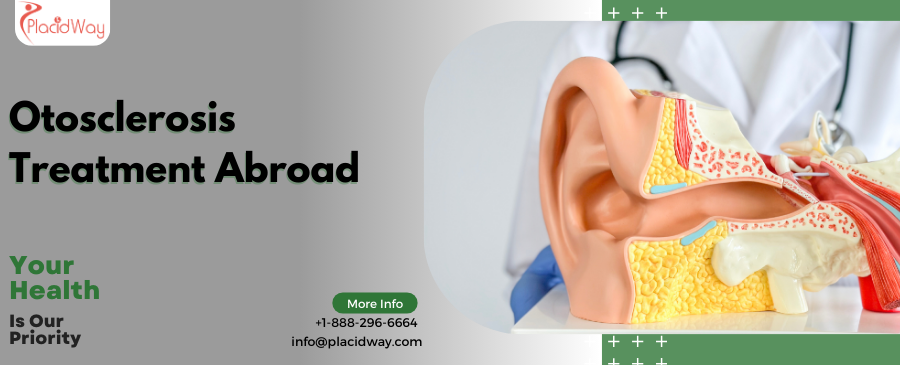
Rediscover Sound: Your Guide to Otosclerosis Treatment & Stapedectomy Abroad
Imagine a world where sounds gradually fade, where conversations become a strain, and the simple joy of music or birdsong diminishes. For millions, this is the reality of Otosclerosis, a condition that silently steals your hearing, often affecting both ears over time. But there's good news: Otosclerosis is treatable, and for many, a procedure called stapedectomy surgery can dramatically restore the ability to hear clearly again.
If you're experiencing hearing loss and suspect Otosclerosis, you're not alone. Many individuals worldwide seek effective, affordable, and high-quality treatment options, often looking beyond their borders. This comprehensive guide will walk you through everything you need to know about Otosclerosis, its symptoms, causes, the life-changing stapedectomy procedure, and why considering treatment abroad might be the best decision for your hearing health and your wallet.
We understand the emotional toll hearing loss takes. Our goal is to provide clear, empathetic information to help you navigate your options, empower you with knowledge, and connect you with top-tier medical facilities globally. Let's explore how you can regain your hearing and reconnect with the world of sound.
What exactly is Otosclerosis and how does it affect my hearing?
Otosclerosis is a medical condition characterized by abnormal bone growth in the middle ear. Specifically, it often affects the stapes bone (also known as the stirrup bone), which is the smallest bone in the human body. In a healthy ear, the stapes vibrates freely, transmitting sound waves from the eardrum to the inner ear. With Otosclerosis, new, spongy bone forms around the stapes, causing it to become rigid and "fixated" in place. This prevents the stapes from vibrating properly, which significantly impairs the conduction of sound, resulting in what's known as conductive hearing loss.
Over time, this bone growth can progress, leading to a worsening of hearing. While primarily causing conductive hearing loss, in some cases, the abnormal bone growth can also affect the inner ear, leading to sensorineural (nerve-related) hearing loss, or a mixed hearing loss.
What are the common symptoms of Otosclerosis that I should be aware of?
Recognizing the symptoms of Otosclerosis is the first step towards diagnosis and treatment. People often notice symptoms gradually, which can make it hard to pinpoint when the problem began. Here are the key indicators:
- Progressive Hearing Loss: This is the hallmark symptom. It often starts subtly and worsens over time. Initially, you might struggle to hear low-frequency sounds or whispers. Many patients report "better hearing in noisy environments" (a phenomenon called paracusis Willisii) because others speak louder. The hearing loss can begin in one ear but usually affects both.
- Tinnitus: A persistent ringing, buzzing, roaring, or hissing sound in the ear(s) is very common with Otosclerosis. This can vary in intensity and may be more noticeable in quiet environments.
- Dizziness or Vertigo: While less common, some individuals may experience episodes of dizziness, lightheadedness, or vertigo, especially if the disease affects the inner ear.
- Difficulty hearing whispers: Often, conversations are fine, but trying to understand soft speech becomes a significant challenge.
- Speech sounds muffled: Your own voice might sound unusually loud to you, causing you to speak more softly.
If you're experiencing any of these symptoms, especially a gradual decline in your hearing, it's crucial to consult an audiologist or an ENT specialist for a proper diagnosis. Early diagnosis of "otosclerosis hearing loss" can lead to more effective treatment.
What causes Otosclerosis, and am I at higher risk?
While the precise cause of Otosclerosis remains somewhat elusive, several factors are believed to play a role:
- Genetic Predisposition: Otosclerosis often has a familial link, meaning it runs in families. If one of your parents or close relatives has the condition, your risk increases. This suggests a significant genetic component, with several genes potentially involved.
- Hormonal Factors: The condition is twice as common in women as in men, and its onset or worsening is often associated with hormonal changes, particularly during pregnancy. This correlation points to a possible hormonal influence.
- Measles Virus: Research has suggested a link between the measles virus and Otosclerosis. Remnants of the measles virus have been found in the stapes bone of some individuals with Otosclerosis, indicating that a past infection might trigger or contribute to the abnormal bone growth.
- Autoimmune Factors: Some theories suggest that Otosclerosis might have an autoimmune component, where the body's immune system mistakenly attacks its own tissues, leading to inflammation and abnormal bone remodeling.
Risk factors include a family history of Otosclerosis, being female, and having a history of measles. If you're wondering "is otosclerosis genetic?" the answer is often yes, it can be passed down through generations.
What are the main treatment options available for Otosclerosis, including stapedectomy?
When diagnosed with Otosclerosis, your doctor will discuss the available treatment options. These primarily fall into two categories:
- Stapedectomy Surgery: This is the most effective and common treatment for Otosclerosis. During a stapedectomy, a highly skilled ear surgeon (otologist) removes the fixed stapes bone and replaces it with a tiny prosthetic device, often made of Teflon or titanium. This new prosthesis allows sound waves to be transmitted effectively from the eardrum to the inner ear, restoring hearing. The success rate of stapedectomy is very high, with significant hearing improvement reported in over 90% of cases. Many patients search for "otosclerosis surgery" or "stapedectomy for hearing loss" as their best solution.
- Hearing Aids: For individuals who are not surgical candidates, or who prefer a non-surgical approach, hearing aids can effectively amplify sound and improve communication. While hearing aids do not cure Otosclerosis, they can significantly manage the symptoms of hearing loss. They are an excellent option for mild to moderate hearing loss, or for patients who need to delay surgery.
- Fluoride Therapy: In some cases, sodium fluoride may be prescribed to slow down the progression of the disease, particularly in early stages or when there's inner ear involvement. Its effectiveness is debated and it's not a primary solution for restoring hearing.
Your ENT specialist will help determine the best course of action based on the severity of your hearing loss, your overall health, and your personal preferences. For those seeking a definitive solution, stapedectomy remains the gold standard.
Who is a good candidate for Otosclerosis surgery (stapedectomy)?
Deciding if "otosclerosis treatment surgery" is right for you involves a thorough evaluation by an ENT specialist or otologist. Generally, ideal candidates for a stapedectomy meet the following criteria:
- Diagnosed with Otosclerosis: A clear diagnosis of conductive hearing loss due to Otosclerosis, confirmed by audiograms and other diagnostic tests.
- Significant Hearing Loss: The hearing loss should be significant enough to impact daily life and communication, and not easily managed by hearing aids alone.
- Good Inner Ear Function: While Otosclerosis primarily causes conductive hearing loss, it's important that your inner ear (cochlea) function is relatively healthy. The surgery aims to improve sound transmission *to* a functional inner ear.
- Good General Health: Candidates should be in good overall physical health to undergo surgery and anesthesia. Certain chronic conditions might need to be managed before surgery.
- Age: While there's no strict age limit, stapedectomy is typically performed on adults and sometimes on adolescents.
- Realistic Expectations: Patients should understand the potential benefits and risks of the procedure and have realistic expectations about the extent of hearing improvement.
- No Active Ear Infections: It's crucial that there are no active ear infections at the time of surgery.
A comprehensive consultation, including detailed hearing tests and medical history review, will determine your eligibility for this transformative procedure. You might ask, "is otosclerosis curable with surgery?" and for most candidates, the answer regarding hearing restoration is a resounding yes.
What does recovery from a stapedectomy involve, and when can I expect improved hearing?
Knowing what to expect during the "stapedectomy recovery period" can help you prepare for a smooth healing process. Here’s a general timeline and what you might experience:
- Immediately After Surgery: You'll likely experience some dizziness, nausea, and a feeling of fullness or "plugged ear." This is normal and usually subsides within a few hours to a few days. You may have a small dressing or packing in your ear.
- First Few Days: Rest is crucial. Avoid sudden head movements, heavy lifting, straining, and blowing your nose forcefully. Your doctor will likely prescribe pain medication and possibly antibiotics. You'll need to keep your ear dry.
- First Week: The dizziness should decrease significantly. You might notice some initial improvement in hearing, but it's important to remember that swelling and residual fluid in the ear can temporarily muffle sounds.
- Weeks 2-4: Most patients can return to light activities. The packing may be removed during a follow-up appointment. As swelling subsides, your hearing will progressively improve. Some patients describe a "whooshing" or "crinkling" sound as their ear adjusts.
- Full Recovery: Complete healing and maximum hearing improvement typically occur within 4-6 weeks, though it can take a few months for some individuals. A post-operative audiogram will confirm the extent of your hearing restoration.
It’s important to follow your surgeon’s specific post-operative instructions carefully to ensure the best possible outcome for your "stapedectomy recovery time."
What are the potential risks and side effects of Otosclerosis surgery?
Like any surgical procedure, a stapedectomy carries some potential risks and side effects, though serious complications are rare. It's essential to discuss these thoroughly with your surgeon before making a decision. Common "stapedectomy complications" and risks include:
- Dizziness/Vertigo: Common immediately after surgery, but usually resolves within days or weeks. Persistent dizziness is rare.
- Taste Disturbances: The chorda tympani nerve, which controls taste to the front of the tongue, runs through the middle ear and can be affected during surgery. This can lead to a temporary or, less commonly, permanent alteration in taste on one side of the tongue.
- Tinnitus: While surgery often improves or resolves existing tinnitus, in rare cases, it can worsen or develop anew.
- Perforation of the Eardrum: Although uncommon, the eardrum can be accidentally punctured during the procedure.
- Facial Nerve Injury: Extremely rare, but the facial nerve, which controls facial movements, runs close to the surgical area. Injury could lead to temporary or permanent facial weakness.
- Complete Hearing Loss: While the goal is to improve hearing, there is a very small risk (less than 1%) of the surgery resulting in total hearing loss in the operated ear. This is often associated with inner ear damage.
- Infection: As with any surgery, there's a risk of developing an ear infection, though antibiotics are usually prescribed to minimize this.
- Failure of the Prosthesis: Rarely, the prosthetic device may shift or fail, requiring further surgery.
Your surgeon will take every precaution to minimize these risks, and a detailed discussion will ensure you're fully informed about "stapedectomy risks and complications."
Why should I consider Otosclerosis treatment abroad, and what are the benefits?
For many patients, especially those in countries with high healthcare costs or long waiting lists, seeking Otosclerosis treatment abroad has become an increasingly attractive option. Here's why:
- Cost Savings: This is often the primary motivator. The cost of a stapedectomy can be prohibitively expensive in countries like the US, Canada, or the UK. Medical tourism destinations offer the same or even higher quality care at a fraction of the price, making life-changing surgery accessible.
- Access to Expertise and Technology: Many international hospitals specialize in ear surgery and boast world-renowned otologists and state-of-the-art diagnostic and surgical equipment. These facilities often handle a high volume of stapedectomy cases, leading to greater surgeon experience.
- Reduced Waiting Times: In some healthcare systems, waiting lists for specialized surgeries can be lengthy, delaying necessary treatment. Traveling abroad can offer immediate access to care, allowing you to address your hearing loss sooner.
- Privacy and Comfort: International medical facilities often cater to a discerning clientele, offering luxurious accommodations, personalized care, and a discreet environment for recovery, sometimes combined with a relaxing travel experience.
- Comprehensive Packages: Many medical tourism providers offer all-inclusive packages that cover surgery, accommodation, airport transfers, and even post-operative care, simplifying the entire process for the patient.
- High Success Rates: Top clinics abroad maintain excellent success rates for stapedectomy, comparable to or even exceeding those in Western countries.
If you're asking "Is otosclerosis surgery worth it abroad?", the answer, for many, is a resounding yes, given the potential for significant savings and high-quality care.
Which countries offer the best value and quality for stapedectomy procedures?
When considering "stapedectomy surgery cost abroad," it's important to weigh both affordability and the reputation for quality. Several countries have emerged as leading destinations for medical tourists seeking Otosclerosis treatment:
- India: Known for its highly skilled surgeons, advanced medical infrastructure, and exceptionally competitive pricing. India offers world-class ENT care at a fraction of Western costs.
- Turkey: Istanbul and other major cities boast modern hospitals, internationally trained specialists, and a strong focus on medical tourism. Excellent quality of care with attractive pricing.
- Mexico: Particularly popular with patients from the US and Canada due to its proximity. Mexico offers accredited hospitals and experienced surgeons, often with packages tailored for international visitors.
- Thailand: A long-standing leader in medical tourism, Thailand combines excellent medical care with renowned hospitality. Facilities are modern, and prices are competitive.
- South Korea: Emerging as a hub for advanced medical procedures, South Korea offers cutting-edge technology and highly specialized doctors, though prices might be slightly higher than other Asian destinations.
Worldwide Cost Comparison for Stapedectomy (Estimated)
Please note: Prices are estimates and can vary significantly based on the clinic, surgeon's experience, complexity of the case, and included services (e.g., hospital stay, post-op care, accommodation). This table provides a general idea of "otosclerosis surgery cost":
| Country | Estimated Cost (USD) | Key Advantages |
|---|---|---|
| United States | $15,000 - $35,000+ | Advanced technology, high standards (but high cost) |
| United Kingdom | $10,000 - $20,000+ | NHS (long waits), private options available |
| India | $3,000 - $6,000 | Highly experienced surgeons, very affordable, modern facilities |
| Turkey | $4,000 - $8,000 | European standards, advanced hospitals, excellent patient care |
| Mexico | $5,000 - $9,000 | Proximity to US/Canada, accredited facilities, packages |
| Thailand | $4,500 - $8,500 | World-renowned hospitality, modern private hospitals |
These figures are averages and can vary. It's crucial to get a personalized quote for your specific needs.
How can I ensure a safe and successful experience when traveling for Otosclerosis surgery?
Embarking on a medical journey abroad requires careful planning and due diligence. Here’s how you can maximize your chances of a safe and successful Otosclerosis treatment experience:
- Choose Accredited Facilities: Look for hospitals that have international accreditations like JCI (Joint Commission International). This indicates adherence to stringent quality and patient safety standards, comparable to top Western hospitals.
- Verify Surgeon Credentials: Research your surgeon's qualifications, experience, and specialization in otology and stapedectomy procedures. Inquire about their success rates and how many similar surgeries they perform annually. Ask for patient testimonials or success stories where possible.
- Utilize Reputable Medical Tourism Facilitators: Companies like PlacidWay specialize in connecting patients with trusted international providers. They can help with vetting clinics, managing logistics, facilitating communication, and understanding package deals.
- Ask for All-Inclusive Packages: Ensure your quote includes everything: surgeon fees, anesthesia, hospital stay, medications, necessary tests, and follow-up care. Clarify what's *not* included.
- Clear Communication: Ensure there's a clear communication channel with your medical team, ideally in your native language or with professional translation services.
- Pre-Operative Consultations: Arrange virtual consultations with your prospective surgeon to discuss your case, expectations, and any concerns.
- Post-Operative Care Plan: Understand the post-operative care instructions, follow-up schedule, and how complications will be managed, both while abroad and upon your return home. Discuss options for follow-up with your local ENT if possible.
- Travel Insurance: Obtain comprehensive travel and medical insurance that covers potential complications or unexpected medical needs abroad.
- Read Reviews and Testimonials: Look for reviews from other medical tourists who have undergone stapedectomy in your chosen destination or clinic.
By taking these steps, you can confidently navigate the medical tourism landscape and achieve positive outcomes for your "hearing restoration surgery."
Take the Next Step with PlacidWay
Ready to explore treatment options abroad? Discover top clinics, compare prices, and get a free quote tailored to your needs with PlacidWay. Regain your hearing and reconnect with the world of sound.









Share this listing